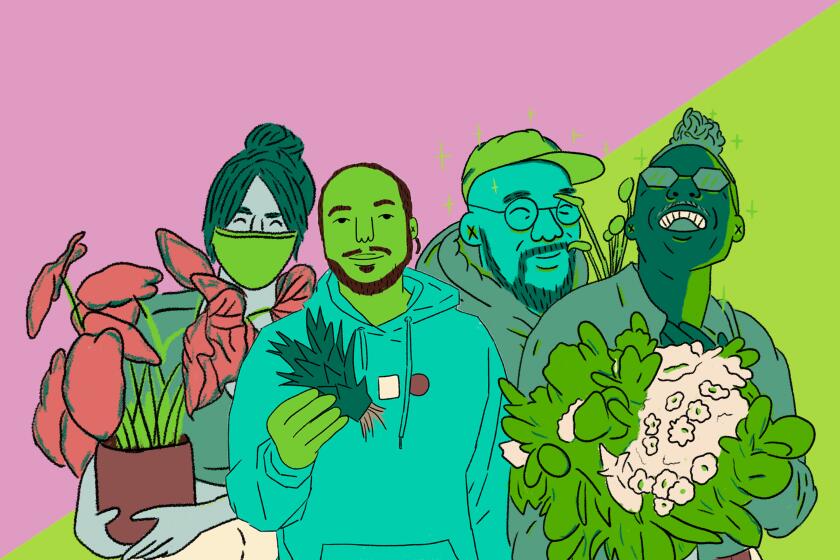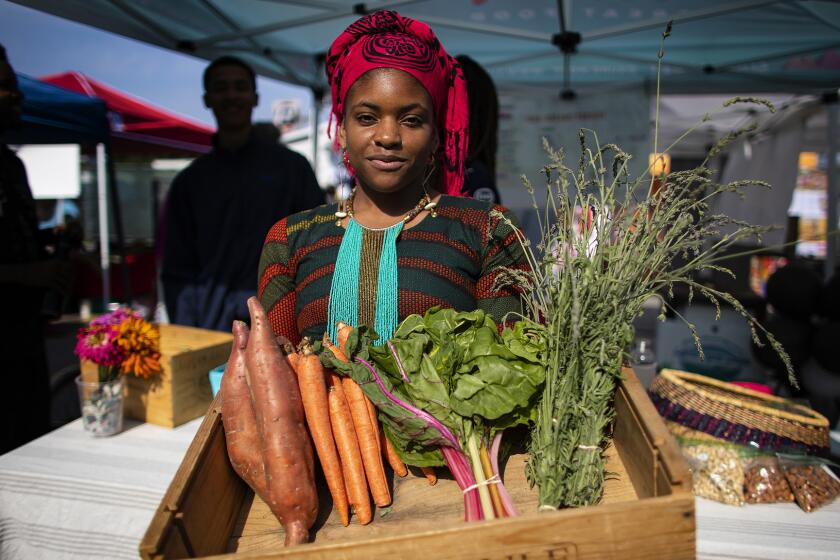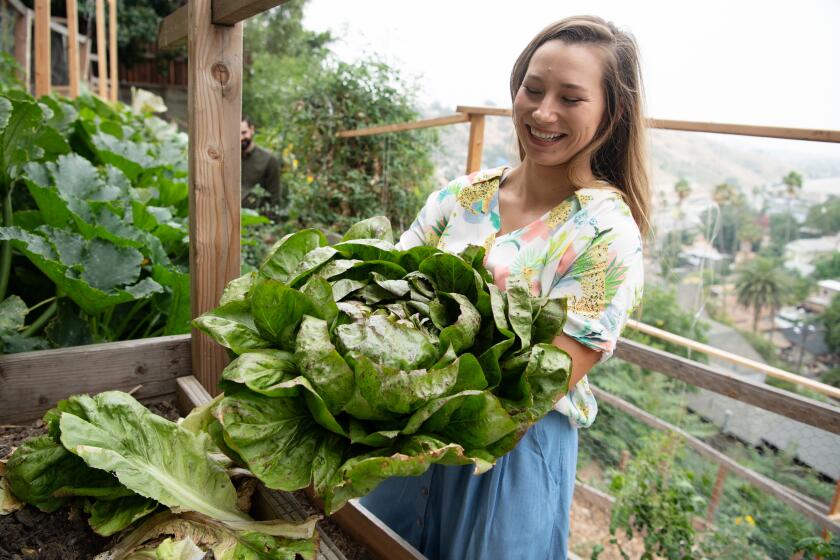A master gardener transforms a South L.A. food desert into an edible oasis
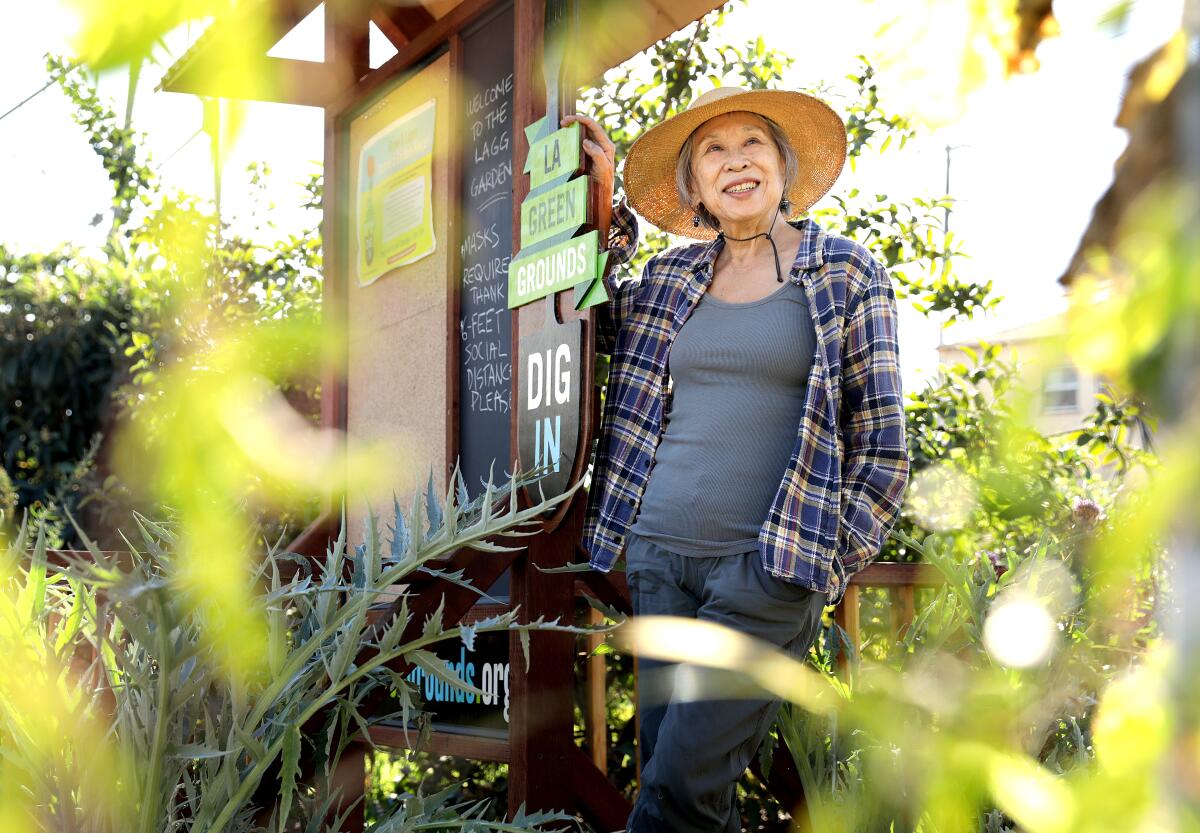
- Share via
This is the latest in a series we call Plant PPL, where we interview people of color in the plant world. If you have any suggestions for PPL to include in our series, tag us on Instagram @latimesplants.
On the eastern end of a large plot of LADWP-owned land in South Los Angeles, a petite woman wearing a face mask and wide-brim sun hat stands at a card table and transplants small purple mustard seedlings into recycled newspaper pots.
She is surrounded by succulents, which she imported from her home garden to create a barrier from street traffic. Power lines tower above her and a field of edible plants — speckled lettuce, kohlrabi, okra and red mizuna lettuce. A tropical luffa grows alongside purple amaranth while ladybugs are drawn to the tall, fragrant stalks of fennel.
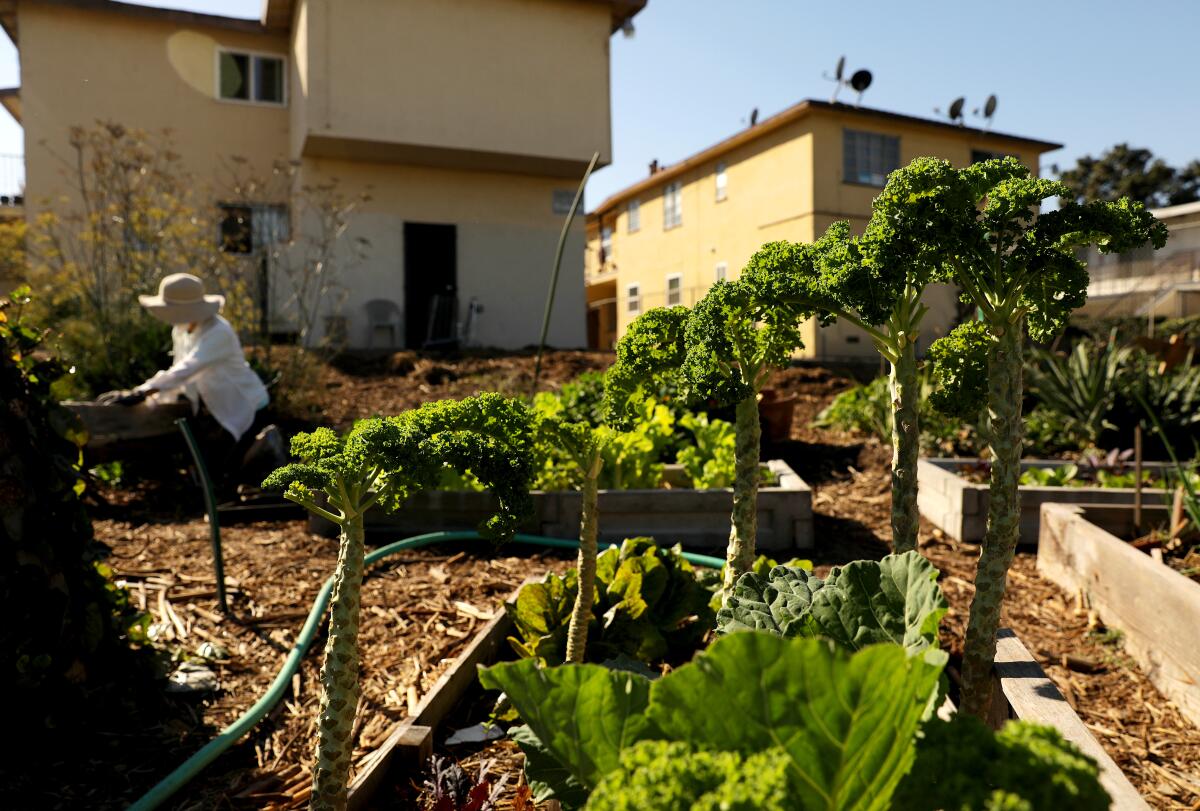
When a woman from a nearby apartment hesitantly wanders into the demonstration garden without a face mask, master gardener Florence Nishida immediately grabs one for her and proceeds to show her around the L.A. Green Grounds demonstration garden.
“That is quintessential Florence,” says Rachel Surls, sustainable food systems advisor for UC Cooperative Extension in Los Angeles County. “She is an amazing mentor and teacher to so many people. She would never send somebody away.”
“Do you like spinach?” Nishida asks. She bends down to tear off a piece of the Malabar variety for the woman: The leaf is crunchy and tastes like lemon and pepper. “It is great cooked with Indian spices,” Nishida says. “Did you know it was discovered by botanist Joseph Banks? He sailed with Captain Cook.”
In our Plant PPL series, we interview people of color in the plant world, including plantfluencers, plant stylists, floral artists, enthusiasts, experts and garden store owners.
Teaching comes naturally to Nishida. The 82-year-old worked as a high school English teacher in Lincoln Heights and a librarian for People magazine before becoming a master gardener and urban farming advocate. She has an encyclopedic knowledge of the garden and can connect plants to historical anecdotes as if recalling a card catalog number. (“Green Glaze is the oldest available variety of collard grown in North America,” she says while tearing off samples. “It was probably in Thomas Jefferson’s garden.”) She is a strong supporter of plants that have a long harvest season and offers her patrons suggestions on how to cook them.
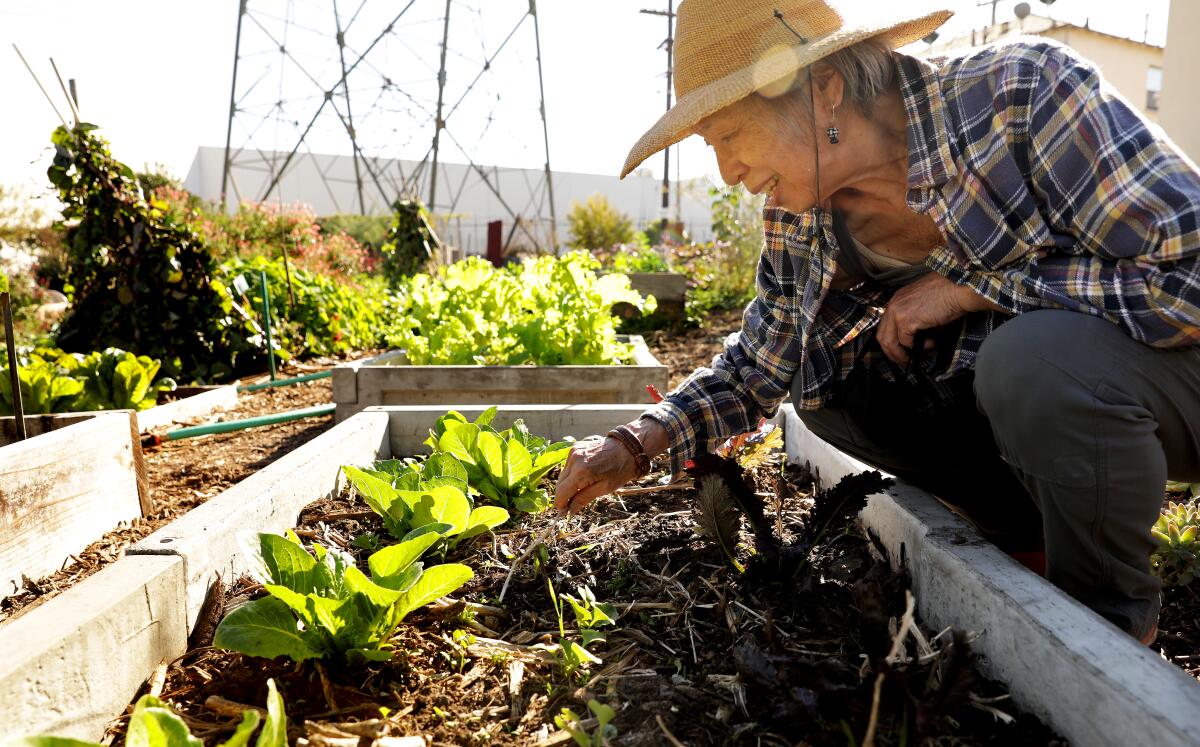
Like many gardeners, Nishida is fascinated by the natural world. She is an expert on mushrooms. Spiders, snakes and fungi delight her. “It is so satisfying to show how we can transform a very barren, lifeless parcel of ground into a welcome oasis for biological beings, including humans, in the city,” she says.
Nishida, who is Japanese American, knows something about what it’s like to grow up in a densely populated “food desert” where grocery stores are scarce and Japanese Americans live alongside Black and Hispanic people. Her family moved to South Los Angeles — then called South Central — after being released from the Poston Internment Camp in Arizona. They settled on 37th Drive and Normandie Avenue, just a block from Exposition Boulevard.
COVID-19 unveiled many of the health disparities in communities of color, with Black and Latino people more than four times as likely to be hospitalized than their white counterparts.
“Back in those days, it was a redlined neighborhood,” she recalls. “Exposition was the southern border beyond which no one but white people could buy a house. We were also several blocks east of Arlington, the other color line. I grew up, therefore, in a highly unsegregated, diverse community of Black, Hispanic, Asian and white people. It was great until the population shifts of the 1950s and ’60s.”
Nishida lived within walking distance of the Natural History Museum. She frequented the museum when she was a girl and later worked there as a research associate. After she retired in 2008, she became a UCCE certified master gardener and started teaching beginning gardening classes at the Natural History Museum and the Grow L.A. Victory Garden Initiative.
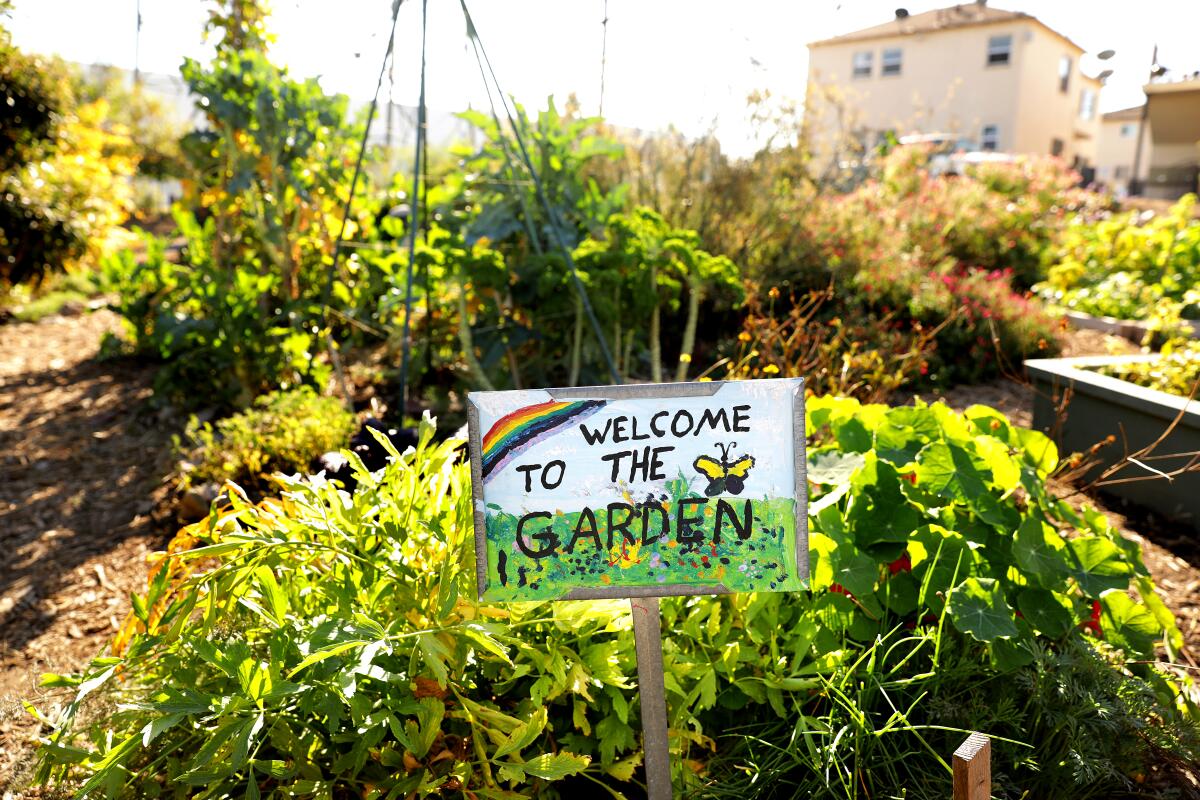
In 2010, she cofounded the grassroots nonprofit L.A. Green Grounds with former student Ron Finley, who has been acknowledged for his role as the self-proclaimed Gangsta Gardener, and Vanessa Vobis. She chose the location, adjacent to the Good Earth Community Garden, because it was open, unused and uncultivated.
“I wanted the garden to demonstrate food growing but also natural history — the connections between plants, insects, birds, humans, the soil, mulches,” Nishida says.
The teaching garden, which was once barren dirt that neighborhood cars drove across, is wedged between a row of apartment buildings and single-family homes. It is unfenced by design, she says, so that anyone can “use it as a peaceful sanctuary, to watch birds or butterflies, to taste the fruit, to watch things grow.”
Joanna Bassi’s days as a television production assistant were stressful and uninspired. She had to change her life. Her first step: “I looked at the weeds growing on my hillside and thought, ‘I want to create an ecosystem.’”
Recently, a neighbor entered the yard and harvested all of the pomegranates. Grace Yamamura, a regular volunteer at L.A. Green Grounds, says, “Florence’s philosophy is, ‘if someone took them, they must have needed them.’”
In addition to her teaching duties, Nishida and the volunteers at Green Grounds are the driving force behind more than 35 “Dig-Ins,” community-driven workdays where volunteers, neighbors and family friends transform front yards and parkways into edible gardens. Garden applicants must live in South L.A., and the garden is required to be visible to the public as a way to provide inspiration and encouragement to others.
“People often don’t know their neighbors,” Nishida says. “It’s amazing how well people work with people they’ve never met before. The Dig-Ins really help build community.”
Yamamura has helped with three “Dig-Ins,” including at Finley’s property on Exposition Boulevard. “Florence is very persuasive in terms of getting people to do backbreaking work,” she says. “It’s hard work but so much fun. I think it’s quite extraordinary that we can transform someone’s yard into a beautiful garden. People really appreciate it.”
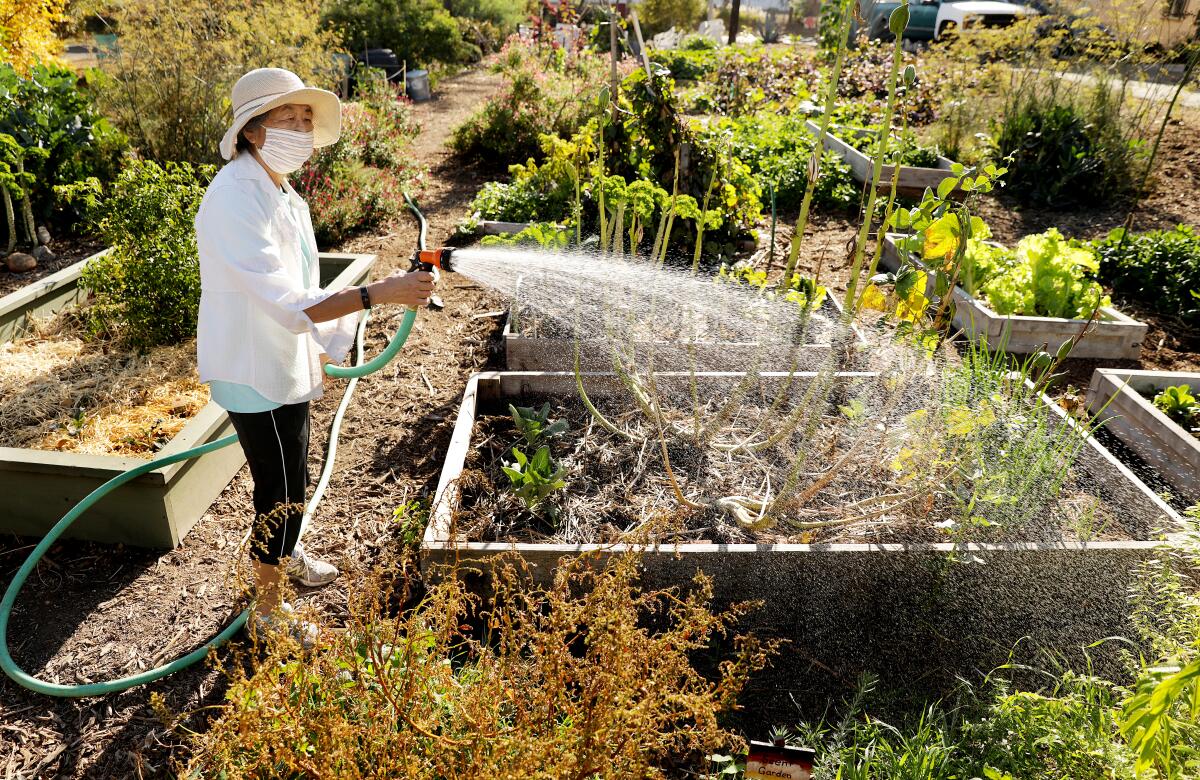
The city of Los Angeles hasn’t always been so hospitable to transformative work. In 2011, Finley received a citation to remove his demonstration garden because it was planted on a city-owned parkway. Nishida intervened, contacting The Times’ Steve Lopez, who drew attention to the predicament.
For the next two years, Nishida attended urban agriculture meetings and reached out to city officials, arguing, “Poor access to good, fresh food led to poor diets that were directly related to poor health among many in the South L.A. communities.” In 2013, the L.A. City Council voted to allow Los Angeles residents to plant edibles in their parkways without a permit.
“I’m proud of helping to change the parkway ordinance,” Nishida says of her efforts.
In many ways, the movement that Nishida started in 2010 feels more relevant than ever during the coronavirus pandemic. “People who have had to stay home or lost employment have become so much more interested in growing their own food,” Surls says. “Seed companies are selling out of seeds. Our role has become more important because there are more people who need help.”
The Dig-Ins and in-person victory garden classes have been sidelined due to the pandemic, but Nishida continues to work with volunteers at the teaching garden on Tuesdays and Saturdays and teaches hybrid classes for the master gardeners program.
Looking back over the troubled last year, she sees how easy it is to feel discouraged about the future. Still, she is hopeful.
“As I drove down Exposition or Vermont for years, I noted the changes to the neighborhood,” she says. “I’m more hopeful now than 20 years ago and at the same time concerned about gentrification. The main thing now is sharing the love of and knowledge of growing and of nature. People need a connection with nature and especially in essential ways, not just as an occasional or rare hike or walk in the woods. They need a sense of accomplishment and personal growth. Seeing and then harvesting something that you started is a hugely rewarding experience. Gardening your own food can do that.”
More to Read
Sign up for The Wild
We’ll help you find the best places to hike, bike and run, as well as the perfect silent spots for meditation and yoga.
You may occasionally receive promotional content from the Los Angeles Times.
